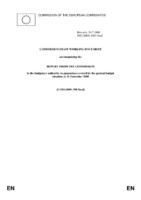| dc.description.abstract | The purpose of Tables A1 and A2 is to show the outstanding amount and annual repayments of capital and interest in respect of borrowing and lending operations for which the risk is covered by the Budget. The figures show the maximum possible risk for the Community in respect of these operations and must not be read as meaning that these amounts will actually be drawn from the Fund or the Budget. In these tables, figures related to “New Member States” refer to the Member States which acceded to the European Union on 1 May 2004 and on 1 January 2007. 1.1.1.Authorised ceiling (Table A1) This is the aggregate of the maximum amounts of capital authorised (ceilings) for each operation decided by the Council. In order to relate it to the risk which the Budget might have to cover, account should be taken of the following factors which could affect it: Factor increasing the risk: •the interest on the loans must be added to the authorised ceiling. Factors reducing the risk: •limitation of the guarantee given to the EIB1: 75% of the total amounts of loans signed in the Mediterranean countries based on the Mediterranean protocols of 1977 and Council Regulations 1762/92/EEC and 1763/92/EEC. 70% of the total amounts of loans signed as part of lending operations with certain non-Member States authorised by Council Decisions 96/723/EC, 97/256/EC, 98/348/EC and 98/729/EC and a sharing of risk between the Community and the EIB as the Budget guarantee covers only political risks in some cases; 65% of the total amounts of loans signed as part of financing operations with certain non-Member States authorised by Council Decisions 99/786/EC, 2000/24/EC and 2006/1016/EC, and a sharing of risk between the Community and the EIB as the Budget guarantee covers only political risks in some cases; •operations already repaid, since the amounts concerned are the maximum amounts of capital authorised (ceilings) and not outstanding amounts; •the ceilings are not necessarily taken up in full. Another factor to be considered is that some loans are disbursed in currencies other than the EUR. Due to exchange rate fluctuations, the ceiling may be exceeded when the amounts disbursed up to the date of the report are converted into EUR |

